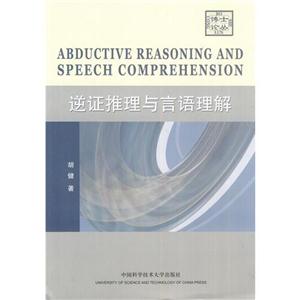Chapter One Introduction 1
1.1 Position and general orientation 2
1.2 Abduction: background and issues 3
1.2.1 Roots of abduction 4
1.2.2 Abduction in everyday life 5
1.2.3 Abduction in scientific reasoning 7
1.2.4 Abduction in artificial intelligence 12
1.3 Organization of the dissertation 15
Chapter Two Towards an Understanding of the Notion of Abduction 18
2.1 Introduction 18
2.2 Peirce's theories of abduction 19
2.2.1 The syllogistic theory 20
2.2.2 The inferential theory 24
2.3 Abduction and induction 29
2.4 Features of Abduction 35
2.5 Abductive reasoning we talk on 39
2.5.1 Abduction: inference to the best explanation 39
2.5.2 Selective abduction and creative abduction 43
2.5.3 Abductive triggers 45
2.5.4 Defining abduction 47
2.6 Chapter summary 48
Chapter Three Cognitive Contexts 52
3.1 Introduction 52
3.2 Study of context: socio-anthropological tradition 52
3.3 Study of context in pragmatics and cognitive linguistics 58
3.3.1 A general introduction 58
3.3.2 Major contextual elements 60
3.3.3 Cognitive context units 61
3.3.3.1 Frame 62
3.3.3.2 Script 65
3.3.3.3 Schema 70
3.3.3.4 Knowledge structures and linguistic interpretation 75
3.4 Chapter summary 78
Chapter IV Abductive Reasoning in Natural Language 80
Interpretation and Pragmatic Inference as Abduction 80
4.1 Introduction 80
4.2 Abduction in natural language interpretation 81
4.3 Verbal communication paradigms 84
4.3.1 Encoding and decoding paradigm 84
4.3.2 Communicative intentions 85
4.3.3 Perspective taking 87
4.3.4 Dialogism 89
4.3.5 Conclusion 91
4.4 Pragmatic inference and abductive reasoning 92
4.4.1 Cooperative principle and conversational implicature 93
4.4.2 Relevance theory 97
4.4.3 Abductive reasoning and pragmatic inference 104
4.4.4 Principle of economy 111
4.5 Chapter summary 116
Chapter Five Creative Abduction and linguistic Interpretation 118
5.1 Introduction 118
5.2 Three categories of creative abduction in linguistic interpretation 119
5.2.1 Realizing new meanings 120
5.2.2 Resolving anomalies or inconsistencies 124
5.2.3 Understanding novelties 130
5.3 Interpretation as abductive transformation 139
5.3.1 Abduction and BK alteration 140
5.3.2 Interpretation as abductive transformation 142
5.4 Chapter Summary 147
Chapter Six Conclusion 149

















